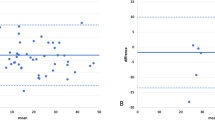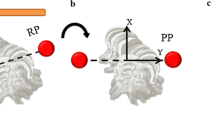Abstract
Study Design
Three-dimensional (3D) spinal models of children with idiopathic scoliosis (IS) were created using the EOS imaging system (EOS) and sterEOS software.
Objective
To determine the inter- or intraobserver reproducibility of the 3D spinal models in children with IS of different apex locations.
Summary of Background Data
3D spinal model measurements include the Cobb angle, kyphosis, lordosis, and axial vertebral rotation (AVR). Variation of these measurements between two investigators and two different trials by the same investigator were analyzed by inter- and intraclass correlation coefficients (ICCs).
Methods
Biplanar radiographic images of 15 patients (age: 6–15 years) with IS were uploaded into the sterEOS software. Spinal and pelvic markers were manually identified to construct a 3D spinal model and measure spinal parameters. Two trained examiners independently performed modeling and performed modeling in spaced out trials. The ICC between inter- and intraobservers were calculated.
Results
ICCs between inter- and intraobservers were significant for all parameters (p < .05). Both the inter- and intraobservers showed excellent agreement for the Cobb angles in the thoracic segment, kyphosis and lordosis. Substantial interobserver agreement and excellent intraobserver agreement were determined for the Cobb angle in the thoracolumbar or lumbar (TL/L) segment, with less than 6° difference between two raters and less than 2° difference between two trials. Substantial interobserver agreement for the AVR in the TL/L region and substantial interobserver agreement for the AVR in the thoracic region were found, with less than 4° difference between raters. One rater had substantial intraobserver agreement for the AVR in the TL/L region whereas another rater reported moderate to substantial intraobserver agreement in both the thoracic and TL/L regions, with less than 3° difference between trials.
Conclusion
The EOS system shows reliable and repeatable results in 3D spinal modeling of children with IS.
Level of Evidence
Level III.
Similar content being viewed by others
References
Stokes IAF. Three-dimensional terminology of spinal deformity: a report presented to the Scoliosis Research Society by the Scoliosis Research Society working group of 3D terminology for spinal Deformity. Spine 1994;19:236–48.
Illés T, Tunyogi-Csapó M, Somoskeöy S. Breakthrough in three-dimensional scoliosis diagnosis: significance of horizontal plane view and vertebra vectors. Eur Spine J 2011;20:135–43.
Labelle H, Aubin C, Lenke L, et al. Seeing the spine in 3D: How will it change what we do? J Pediatr Orthop 2011;31:S37–45.
Cobb JR. Outline for the study of scoliosis. In: Instructional Course Lectures, vol. 5. The American Academy of Orthopedic Surgeons. Ann Arbor, MI: J.W. Edwards; 1948. p. 261–75.
Dubousset J, Ilharreborde B, Le Huec JS. Use of EOS imaging for the assessment of scoliosis deformities: application to postoperative 3D quantitative analysis of the trunk. Eur Spine J 2014;23:S397–405.
Dubousset J. Importance of the three-dimensional concept in the treatment of scoliotic deformities. In: Dansereau J, editor. International symposium on 3D scoliotic deformities joined with the VIIth international symposium on spinal deformity and surface topography. Jena, Germany: Gustav Fisher Verlag; 1992. p. 302–11.
Levy AR, Goldberg MS, Mayo NE, et al. Reducing lifetime risk of cancer from spinal radiographs among people with adolescent idiopathic scoliosis. Spine 1996;21:1540–7.
Pomero V, Mitton D, Laporte S, et al. Fast accurate stereoradio-graphic 3D-reconstruction of the spine using a combined geometric and statistic model. Clin Biomech 2004;19:240–7.
Wade R, Yang H, Mckenna C, et al. A systematic review of the clinical effectiveness of EOS 2D/3D x-ray imaging system. Eur Spine J 2013;22:296–304.
Yazici M, Acaroglu ER, Alanay A, et al. Measurement of vertebral rotation in standing versus supine position in adolescent idiopathic scoliosis. J Pediatr Orthop 2001;21:252–6.
Morvan G, Mathieu P, Valérie V, et al. Standardized way for imaging the sagittal spinal balance. Eur Spine J 2011;20:S602–8.
Deschenes S, Charron G, Beaudoin G, et al. Diagnostic imaging of spinal deformities: reducing patient’s radiation dose with a new slot scanning x-ray imager. Spine 2010;35:989–94.
Charpak G. The Nobel Foundation. “The Nobel prize in physics 1992.” http://www.nobelprize.org/nobel_prizes/physics/laureates/1992/index.html.
Illés T, Somoskeöy S. The EOS™ imaging system and its uses in daily orthopaedic practice. Int Orthop 2012;36:1325–31.
Al-Aubaidi Z, Lebel D, Oudjhane K, et al. Three-dimensional imaging of the system: is it reliable? A comparative study using computed tomography imaging. J Pediatr Orthop 2013;22:409–12.
Somoskeöy S, Tunyogi-Csapo M, Bogyo C, et al. Accuracy and reliability of coronal and sagittal spinal curvature data based on patient- specific three-dimensional models created by the EOS 2D/3D imaging system. Spine J 2012;12:1052–9.
Courvoisier A, Ilharreborde B, Constantinou B, et al. Evaluation of a three-dimensional reconstruction method of the rib cage of mild scoliotic patients. Spine Deform 2013;1:321–7.
Rousseau MA, Laporte S, Chavary-Bernier E, et al. Reproducibility of measuring the shape and three-dimensional position of cervical vertebrae in upright position using EOS stereoradiography system. Spine 2007;22:2569–72.
Glaser DA, Doan J, Newton PO. Comparison of 3-dimensional spinal reconstruction accuracy: biplanar radiographs with EOS versus computed tomography. Spine 2012;37:1391–7.
Landis JR, Koch GG The measurement of observer agreement for categorical data. Biometrics 1977;33:159–74.
Courvoisier A, Drevelle X, Dubousset J, et al. Transverse plane 3D analysis of mild scoliosis. Eur Spine J 2013;22:2427–32.
Hong JY, Suh SW, Easwar TR, et al. Evaluation of the three dimensional deformities in scoliosis surgery with computed tomography: efficacy and relationship with clinical outcomes. Spine 2011;36: E1259–65.
Kato S, Debaud C, Zeller RD. Three-dimensional EOS analysis of apical vertebral rotation in adolescent idiopathic scoliosis. J Pediatr Orthop 2017;37:E543–7.
Ilharreborde B, Steffen JS, Nectoux E, et al. Angle measurement reproducibility using EOS three-dimensional reconstructions in adolescent idiopathic scoliosis treated by posterior instrumentation. Spine 2011;36:E1306–13.
Vidal C, Ilharreborde B, Azoulay R, et al. Reliability of cervical lordosis and global sagittal spinal balance measurements in adolescent idiopathic scoliosis. Eur Spine J 2013;22:1362–7.
Lenke LG, Betz RR, Haher TR, et al. Multisurgeon assessment of surgical decision-making in adolescent idiopathic scoliosis: curve classification, operative approach, and fusion levels. Spine 2001;26: 2347–53.
Author information
Authors and Affiliations
Corresponding author
Additional information
Author disclosures: none.
Rights and permissions
About this article
Cite this article
Bagheri, A., Liu, XC., Tassone, C. et al. Reliability of Three-Dimensional Spinal Modeling of Patients With Idiopathic Scoliosis Using EOS System. Spine Deform 6, 207–212 (2018). https://doi.org/10.1016/j.jspd.2017.09.055
Received:
Revised:
Accepted:
Published:
Issue Date:
DOI: https://doi.org/10.1016/j.jspd.2017.09.055




